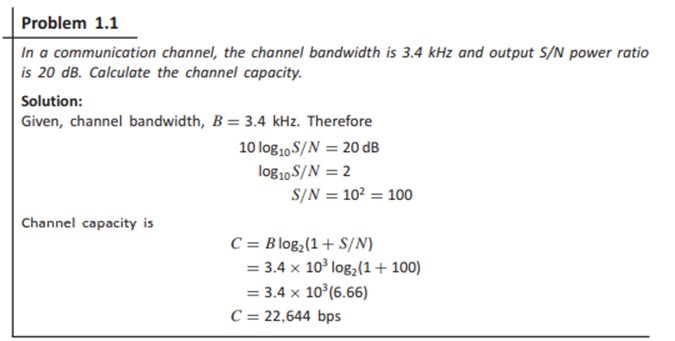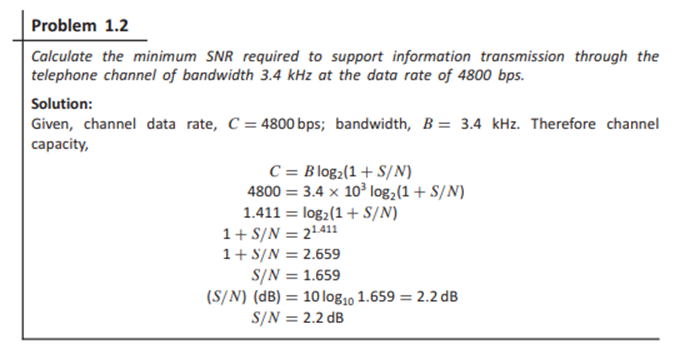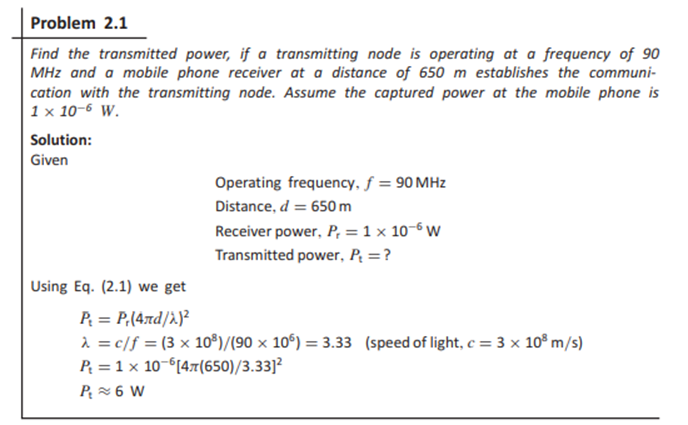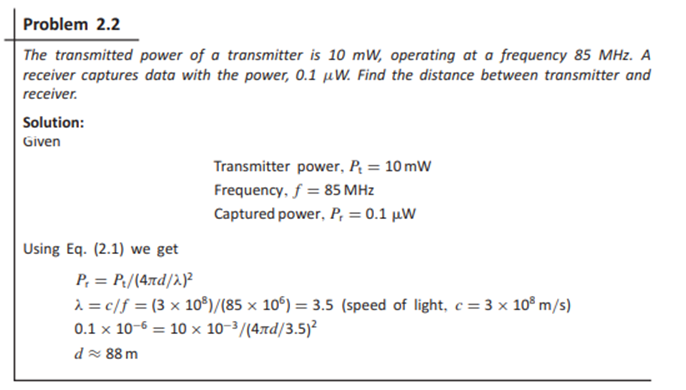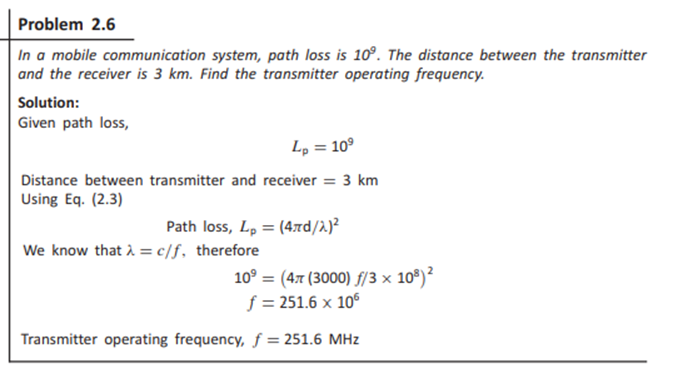Wireless Network and Communications 1st Module
Wireless Communication is a method of transmitting information from one point to other, without using any connection like wires, cables or any physical medium.
A typical Wireless Communication System can be divided into three elements: the Transmitter, the Channel and the Receiver. The following image shows the block diagram of wireless communication system.

The Transmission Path
A typical transmission path of a Wireless Communication System consists of Encoder, Encryption, Modulation and Multiplexing. The signal from the source is passed through a Source Encoder, which converts the signal in to a suitable form for applying signal processing techniques.
The redundant information from signal is removed in this process in order to maximize the utilization of resources. This signal is then encrypted using an Encryption Standard so that the signal and the information is secured and doesn’t allow any unauthorized access.
Channel Encoding is a technique that is applied to the signal to reduce the impairments like noise, interference, etc. During this process, a small amount of redundancy is introduced to the signal so that it becomes robust against noise. Then the signal is modulated using a suitable Modulation Technique (like PSK, FSK and QPSK etc.) , so that the signal can be easily transmitted using antenna.
The modulated signal is then multiplexed with other signals using different Multiplexing Techniques like Time Division Multiplexing (TDM) or Frequency Division Multiplexing (FDM) to share the valuable bandwidth.
The Channel
The channel in Wireless Communication indicates the medium of transmission of the signal i.e. open space. A wireless channel is unpredictable and also highly variable and random in nature. A channel maybe subject to interference, distortion, noise, scattering etc. and the result is that the received signal may be filled with errors.
The Reception Path
The job of the Receiver is to collect the signal from the channel and reproduce it as the source signal. The reception path of a Wireless Communication System comprises of Demultiplexing , Demodulation, Channel Decoding, Decryption and Source Decoding. From the components of the reception path it is clear that the task of the receiver is just the inverse to that of transmitter.
The signal from the channel is received by the Demultiplexer and is separated from other signals. The individual signals are demodulated using appropriate Demodulation Techniques and the original message signal is recovered. The redundant bits from the message are removed using the Channel Decoder.
Since the message is encrypted, Decryption of the signal removes the security and turns it into simple sequence of bits. Finally, this signal is given to the Source Decoder to get back the original transmitted message or signal
Advantages of Wireless Communication
There are numerous advantage of Wireless Communication Technology, Wireless Networking and Wireless Systems over Wired Communication like Cost, Mobility, Ease of Installation, and Reliability etc.
Cost
The cost of installing wires, cables and other infrastructure is eliminated in wireless communication and hence lowering the overall cost of the system compared to wired communication system. Installing wired network in building, digging up the Earth to lay the cables and running those wires across the streets is extremely difficult, costly and time consuming job.
In historical buildings, drilling holes for cables is not a best idea as it destroys the integrity and importance of the building. Also, in older buildings with no dedicated lines for communication, wireless communication like Wi-Fi or Wireless LAN is the only option.
Mobility
As mentioned earlier, mobility is the main advantage of wireless communication system. It offers the freedom to move around while still connected to network.
Ease of Installation
The setup and installation of wireless communication network’s equipment and infrastructure is very easy as we need not worry about the hassle of cables. Also, the time required to setup a wireless system like a Wi-Fi network for example, is very less when compared to setting up a full cabled network.
Reliability
Since there are no cables and wires involved in wireless communication, there is no chance of communication failure due to damage of these cables, which may be caused by environmental conditions, cable splice and natural diminution of metallic conductors.
Disaster Recovery
In case of accidents due to fire, floods or other disasters, the loss of communication infrastructure in wireless communication system can be minimal.
Disadvantages of Wireless Communication
Even though wireless communication has a number of advantages over wired communication, there are a few disadvantages as well. The most concerning disadvantages are Bandwith Interference, Security and Health.
Bandwith
Bandwith is still a limited resource in wireless environments.When transmitting data, users must sometimes send smaller bits of data to accomodate within the available bandwith so that information moves more quickly
Frequency Spectrum
Interference
Wireless Communication systems use open space as the medium for transmitting signals. As a result, there is a huge chance that radio signals from one wireless communication system or network might interfere with other signals.
The best example is Bluetooth and Wi-Fi (WLAN). Both these technologies use the 2.4GHz frequency for communication and when both of these devices are active at the same time, there is a chance of interference.
Security
One of the main concerns of wireless communication is Security of the data. Since the signals are transmitted in open space, it is possible that an intruder can intercept the signals and copy sensitive information.
Health Concerns
Continuous exposure to any type of radiation can be hazardous. Even though the levels of RF energy that can cause the damage are not accurately established, it is advised to avoid RF radiation to the maximum.
Types of Wireless Communications Systems
Some of the important Wireless Communication Systems available today are:
Television and Radio Broadcasting
Satellite Communication
Radar
Mobile Telephone System (Cellular Communication)
Global Positioning System (GPS)
Infrared Communication
WLAN (Wi-Fi)
Bluetooth
ZigBee
Paging
Cordless Phones
Radio Frequency Identification (RFID)
Wireless Communication channel specification
The method of wireless communication channel specification involves allocating the finite resource in two steps:
first the finite resource is allocated for the two directions of transmission and the second,
the portion allocated for each direction is used to create multiple channels for the direction.
These two steps of subdiving the finite are refereed to as:
1. Duplexing methods
2. Multiple access methods
Duplexing methods
There are two main types of duplexing methods:Frequency Division Duplexing and Frequency Division Duplexing
Frequency Division Duplexing
Frequecy divison duplexing is employed in radio systems to provide an uplink and a downlink radio channel between the sender and the reciever, The frequencies are seperated by a duplex spacing.
Users tune between the uplink and downlink frequencies to transmit and receive, respectively.
In wireless communication systems, the direction from user1 to user2 is referred to as the forward direction, and that from users2 to user1, the reverse direction.In the FDD method, the total available bandwith W is first allocated seperately for the forward and reverse directions of transmission.Let the total bandwiths allocated for the forward and reverse directions be Wf and Wr respectively
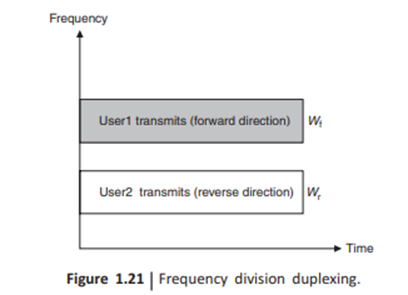
Time Division Duplexing
In TDD, the directions of the transmission are created by alternating the transmission in time. The maximum bit rate Bmax supportable for a given bandwith W is allocated between the two directions.
If this bit rate is equally divided between the two directions, each direction of transmission can support at most Bmax/2.
This method is also colloquially called as ping-pong method. Fig shows that for some time the bandwith was used for user1 to user2 and for other time it was used for user2 to user 1
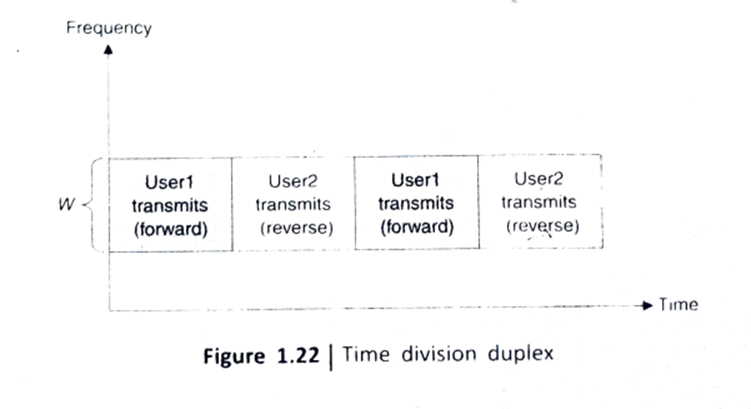
Multiple access methods
The multiple access methods refer to the method of creating multiple channels for each transmisson direction. There are three main types of multiple access methods:
1. Frequency division multiple access (FDMA)
2. Time division multiple access methods(TDMA)
3. Code divison multiple access methods(CDMA)
Frequency Division Multiple Access
FDMA is a channel access method used in multiple access protocols as a channelization protocol. FDMA gives users an individual allocation of one or several frequency bands, or channels, so that receivers can discriminate among them by tuning to the desired channel.
FDMA is a basic technology in the analog advanced mobile phone service(AMPS)
Time division Multiple Access
TDMA is a channel access method for shared medium networks. It allows several users to share the same frequency channelby dividing the signal into different time slots. The users transmit in rapid succession, one after the other, each using his own time slot.
This allows multiple stations to share the same transmission medium(ex- RF channel) while using only a part of its channel capacity
TDMA is used in the digital 2G cellular system such as GSM
Code Division Multiple Access
CDMA is a form of multiplexing where the transmitter encodes the signal using a pseudorandom sequence that the receiver also knows and can use to decode the recieved signal.
Each different random sequence corresponds to a different communciation channel.
Mobile phones standard liuke wideband CDA use this media sharing technique
Wireless Communication problems
1. Shared Media: The wireless media offers lower bandwith inspite of the technique coming up to support Mbps wireless networks. Therefore, the effective utiliziation of bandiwth is necessary for wireless networks.
2.Increased bit error rate (BER): Wireless network media is more prone to errors due to obstacles coming in between the transmitter and the reciever, and the interference caused by neighboring transmitters.
One can observe frequent disconnections causing loss of data and annoying the user especially in voice and video communications
3.Lower radio transmission power: Mobile units are compact in size and work on battery with scarce energy resources. The mobile nodes limit transmission power to avoid interference. Signal Strength decreases with inverse square of distance.
4.Scattering: Scattering occurs when the material through which the wave travels has objects with dimesions that are small compared to the wavelength and where the number of obstacles per unit volume is large.
Scattered waves are produced by rough surfaces,small objects, or other irregularities in the channel.
To provide proper functioning of radio devices in this kind of environment, it is necessary that the radio network design utilizes the correct deployment methedologies ( placement and antenna selection) to minimize this effect.
5.Reflection: Reflection occurs when a propagating electromagnetic wave strikes an object which has very large dimensions compared to the wavelength of the propagating wave for example, walls,furniture, building structure etc.
6.Diffraction: Diffrraction occurs when the radio path between the transmitter and the receiver is obstructed by a surface that has sharp iregularities(edges). The secondary waves resulting from the obstructing surface are present throughout the space and even behind the obstacle.
7.Multiple propagation: The multipath problem in mobile radio is caused by reflection and scattering from building, trees, and other obstacles along the radio path.
Multiple propagation can be a significant problem especially with indoor applications.
Wireless LAN manufracturers compensate for the effects of propagation by using special processing techniques, For ex- equalization and antenna diversity are methods that vendors use to reduce the problems arising from multipath propagation. If significant multipath propagation is present then it may be necessary to operate the wireless LAN at lower data rates.
8.Fading: Signal- fading phenomena can drastically affect the preformance of a wireless communications system. Often caused by multipath conditions fading can degrade the BER perfomance of a digitial communications system, resulting in the data loss.
Fading can occur in amny forms, including a phenomenon called flat fading. In flat flading the same degree of fading takes place for all the frequency components transmited through a radio channel and within the channel bandwith.
In contrast, frequency slective fading causes different frequencies of an input signal to be attenuated and phase shifted differently in a channel.
Wireless Network
Wireless network refers to any type of computer network that is "wireless" and is commonly associated with a telecommunication network whose interconnections between nodes are implemented without the use of wires.
With wireless networking a user can stay connected even when moving around within a given geographic area, and this is why the word "mobility" is sometimes used
Through the use of wirless netwroks, information could be sent could be sent overseas or behind enemy lines easily,efficiently and more reliabily.
Wirless networks provide an inexpensive and rapid way connection to the internet in countries and regions where the telecom infrastructure i poor or there is a lack of resorces as in most developing countries
Classfications of Wireless Networks

1.Wireless Body area Network
WBAN consists of a set of mobile and compact intercommunication sensors, either wearable or implanted into the human body which monitors vital body parameters and movements.
These devices, communicating through wireless technologies transmit data from the body to a home base station, from where the data can be forwarded to a hospital clinic or elsewhere in real time.
Some of the technological requirements of WBAN are
1. use of broadband signaling scheme (possibly ultra wideband, UWB);
2. frequency range below 6GHz
3. support of heterogeneous multihop links to cope with high path loss through the human body
WBAN find application in supervising the health status of patients suffering from chronic diseases, such as diabetes, asthama, heart attacks etc where the long-term logging of patient data is necessary
2. Wireless LAN
Wireless LAN (WLAN) technology provides internet access within a building or a limited outdoor area. WLAN uses spread spectrum or orthogonal frequency division multiplexing modulation technology based on radio waves to enable communication between devices in a limited area.
First used within offices and homes, WLAN technology is now also used in stores and restaurants. The use of home networks has greatly increased as the COVID-19 pandemic has forced office workers, students, teachers and others to work and study from home.
Most home network designs are simple. A modem connects to the cable or fiber from a local service provider. A wireless router is connected to the modem and receives the signal from the modem, which it then broadcasts using a wireless protocol, such as the 802.11 standards.
Office networks are more complicated. Access points (APs) are mounted on the ceiling, with each broadcasting a wireless signal to the surrounding area. Multiple APs are required in large offices, each connecting to the office backbone network via a wired connection to a switch.
3. Wireless MAN
Wireless metropolitan area networks have been installed in cities worldwide to provide access for people outside an office or home network. These networks cover a wider area than office or home networks, but the principles are the same. APs are located on the sides of buildings or on telephone poles throughout the coverage area. APs are connected to the internet via a wired network and broadcast a wireless signal throughout the area. Users connect to their desired destination by connecting to the nearest AP, which forwards the connection through its internet connection.
4. Wireless PAN
Wireless personal area networks cover a very limited area -- typically a maximum of 100 meters for most applications -- using protocols like Bluetooth and Zigbee. Bluetooth enables hands-free phone calls, connects a phone to earpieces or transmits signals between smart devices. Zigbee connects stations along an IoT network. Infrared technology is limited to line of sight, such as connecting TV remotes to televisions.
Wireless developers have constantly improved technology by discovering new ways to transmit signals to users. These advances enable higher data rates and increasing range for each of these wireless technologies.
5. Wireless WAN
A WWAN is a computer netwrom covering a broad geographical area.Wireless WANs use cellular technology to provide access outside the range of a wireless LAN or metropolitan network.
These networks enable users to make phone calls to others connecting either through a wireless WAN or a wired telephone system. Users can also connect to the internet to access websites or server-based applications.
Cell towers are located nearly everywhere within India and most other countries. A user connection is routed to the nearest cell tower which, in turn, is connected either to the wired internet or to another tower connected to wired internet.
Wireless Switching technology
Packet switching is the basic type of wireless switching techmology. packet switching communication uses short bursts of information that use channels only for short periods of time.
Wireless devices are ON with a specific address assigned to them. Data are sent to and from the address routed using standardized protocols and are essentially an extension of the standardized protocol.
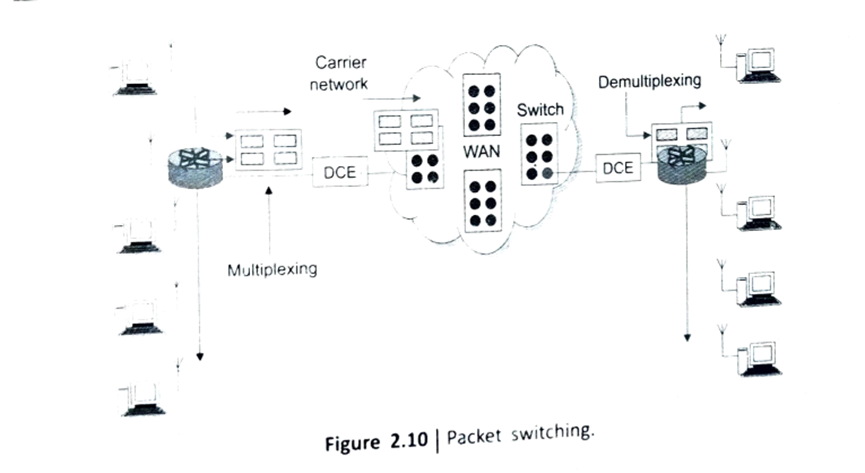
Fig shows the packet switching where the packets from all computer of a premise moves in a pipelined fashion over the nework
This network is connected to the switch of the WAN with the help of data circuit terminated equipment (DCE). Switch establishes a connection from one netwrok to the other network. Whenever the computers generate the packets, they are routed to the carrier network and pipelined with the help of multiplexing technique.
At the recieving end, the packets are demultiplexed and delivered to the destination.
Packet switching is a more efficient sustem for transmitting data because it shares spectrum and bandwith.
Another switching technology is based on virtual circuts. A virtual curcuit is a lgical circuit within a shared netwrok between two network devices. The two types of virtual circuits exists: switched virtual circuits and permanent virtual circuits (PVC)
SVCs are virtual circuits that are dynamically established on demand and terminated when transmission is complete.
Communication over an SVC consits of three phases: circuit establishment, data transfer and circuit termination.
establishment phase involoves creating the virtual circuit between the source and destination devices,Data transfer involves transmitting data between devices and circuit termination involves ending the virtual circuit between source and destination.
PVC is a permanently established virtual circuit that consists of one mode: data transfer.PVC are used in situations in which data transfer between devices is constant.
Wireless networking issues
Traffic and resource allocation
Each accepted connection has a certain traffic contract that describes the traffic type and resource requirements. A slot scheduler is responsoble to assign slots in transmission frame according to the various traffic contracts.
Flow Control
A connection involves buffering at several places on the path between the sender and reciever. Traffic type requirements concerning delay and implementation restrictions on the buffer capacity generally limit the amount of buffer space available to a connection.
Due to the dynamic character of wireless networks and user mobility, the stream of data might be hindered on the way from source to destination . Therefore flow control mechanism are needed not only to revent buffer overflow, but also to discard packets that have exceeded the allowable transfer time.
Security and Privacy
Network security refers to the protection of information and resources from loss corruption and improper use. Eavesdropper may listen to the traffic in real time or record it for future cryptanalysis.
This can be done on radio, link layer (MAC) or network (IP) level. As eavesdropping of the data bits is a real threat because they will be transmitted over wirelessair interface security, security and privacy are important issues in wireless systems.
Power Management
Wireless devices have maximum utility when they can be used anywhere anytime. However the finite power supplies is one of the limitation to achieve this goal. As batteries provide limited power, a general constraint of wireless communication is the short continuous operation time of wireless terminals.
Princing
This deals with the pricing policies in wireless networks. The serice providers should charge the price based on the QOS requirements and the network situations.
Wireless Network standards

Sums-
